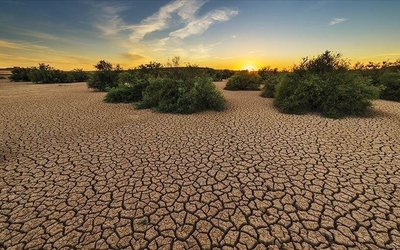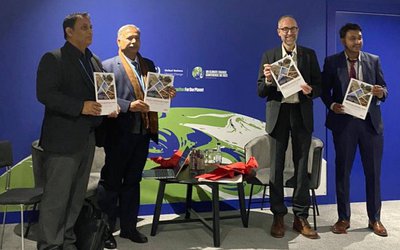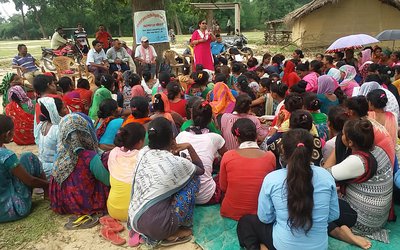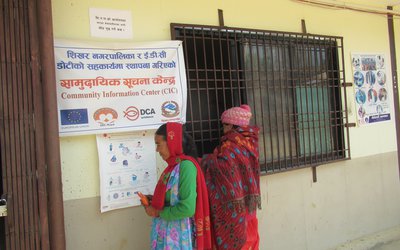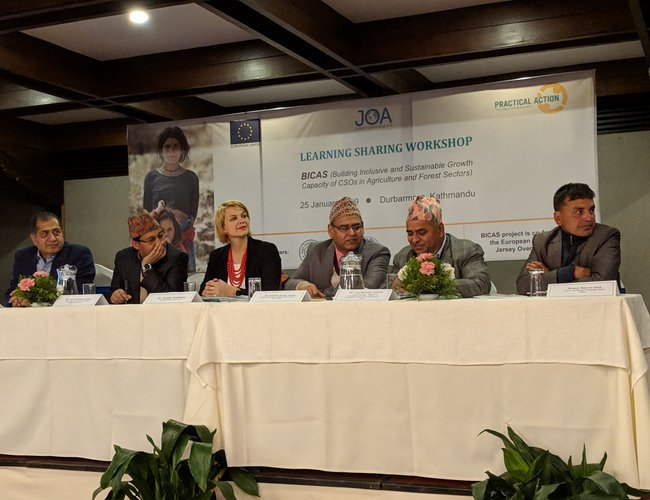
Migrating to India regularly for 27 years in search of seasonal work, Nara Bahadur Rawat, 47, a resident of Jumla, has stopped doing so for the last three years.
With the implementation of BICAS, the father of seven children has found options in his own land to grow vegetables and link his products to the nearby markets. "One of the happiest parts of my life is the breaking of the decades-long cycle of migration to India and growing the agricultural products, such as vegetables, to earn money at home instead," narrates Rawat at a learning and sharing workshop in Kathmandu. "From being an unwanted and low-paid migrant labor, being able to share my experiences with the people here in Kathmandu is another milestone of my life.”
Completing three years, BICAS has come to an end as a project. However, the project has left remarkable impression among the local people in two provinces, Far West and Karnali. Rawat, one of the locals, is all praise for the project.
From new technology for sustainable agriculture, BICAS also enhanced the capacity of the local Community Based Organisations, local levels and local farmers.
Be it elected representatives, beneficiaries such as Rawat, government officials or community based organisations, everyone seems to hail BICAS as a model to replicate in other areas.
"When I was elected one and a half years ago, BICAS was already in the middle of its project period. Working with BICAS in the last one and a half year, we have learnt a lot for future programs. One of the major lessons of the project was how to prevent youth migration. Due to the out-flux of a large number of youth, we have been facing scarcity of working people to carry out development activities," said mayor Dipak Bikram Shah of Budhiganga Municipality of Bajura District of far west region. "BICAS gave local farmers a sustainable livelihood option through modernising and commercialization of agriculture," said mayor Shah at the learning and sharing workshop.
Implemented by Practical Action Nepal in collaboration with local government institutions, local level and local NGOs in five districts of Bajhang, Bajura, Jumla, Kalikot and Mugu, European Union and Jersey Overseas Aid funded the project. Launched in February 2016, BICAS worked until January 2019.
"People have been living in hardship in remote districts of Far West and Midwest. Through the intervention of new technologies in agriculture, livestock and forest sector and ropeways for market linkage, BICAS has also shown the way to develop partnership between CBOs and elected level," said Nir Bahadur Saud, president of HRC.
The project focused on building the capacity of 45 local organizations promoting inclusive and sustainable growth increasing the income of over 7,000 households from agriculture and forest-based enterprises.
"With agriculture and forest based economy, poverty, food insecurity and high migration are common in the remote hilly districts of Far west and Karnali Provinces," said Sujan Piya, head of the project. “Our experiences have shown that introducing new technologies and commercialising the agriculture were key to bringing change in the livelihood."
"The project worked with communities to implement simple, smart solutions and technologies, including upgrading 20 traditional water mills with turbines to better extract water (for drinking, crops and livestock), construction of 10 community managed multi-use water systems for drinking water, irrigation and other services," said Piya.
"We have created 25 pond irrigation schemes, 10 large and 15 small, a demonstration solar-water lifting pump, building and promoting Gravity Goods Ropeways for market linkage are some of the key," said Dr. Piya.
This program has shown visible impacts on food security situation in the rural areas through improving the agricultural input technology, increasing access to smallholders' friendly irrigation scheme, and market system development.
Kalikot, Mugu, Jumla, Bajura and Bahjang are some of the poorest districts of Nepal. Smallholder farmers here struggle to produce enough food to feed their families. Isolation, poor infrastructure and erratic rainfall make the situation worse. Many men migrate to India for work, leaving women to manage families and farms on their own.
Nearly half the population in these districts live below the poverty line and many are also from the most marginalised ethnic groups, including the Dalits and Janjatis. These are often left out at the periphery of decision-making and local development.
Most people in this region, where less than 2% of land is arable, are dependent on agriculture, collection of non-timber forest products, wage labour and remittances for their livelihoods.
How Project Helped?
The project helped communities to increase household income through promoting sustainable growth in agriculture. As the project completed, it benefited over 7,000 smallholder farmers, 30% women, 15% Dalit, 20% Janjati.
Local partners Saipal Development Society, Human Resource Centre, Sustainable and Equitable Development Academy (SEDA) Nepal implemented the project in close partnership with local elected body.
With a funding of €2 million, with principal funders being European Union and Jersey Overseas Aid, the project helped to change the livelihood of the people through intervention in agriculture sector.
"Through small infrastructure development, promotion of new agricultural technologies and market linkages, the project helped over 7,000 smallholder farmers increase their incomes," said Dr. Piya.
Improved water supply and irrigation infrastructure
During the last three years, the project helped in upgrading 20 water mills with turbines to extract water more efficiently for consumption, crops and livestock.
The project also reinforced the water supply through the construction of 25 pond irrigation schemes, 10 community managed water systems and the pilot of a solar-water lifting pump.
Along with infrastructure development, the project also helped to improve knowledge and farming techniques. The project has built an agro-vet network of 20 trained and licensed agro-vets.
Starting from scratch, the project concluded with 70 village animal health workers to serve 7,000 farmers and their 45 cooperatives with services, products and advisory support. This network delivered more than 300 demonstration sessions on micro-irrigation technologies such as drip irrigation, improved harvesting methods and climate-resilient crop selection; they will act as a ‘frontline’ helpdesk to answer farmers’ queries and preoccupations.
"Farming productivity has drastically enhanced through improved crop storage, facilitation of access to market hubs through five new gravity ropeways and capacity building training through the farmers business school and local resource centres," said Piya. "New gravity goods ropeways are helping to deliver link to the markets for agricultural products."
Training for local cooperatives has developed the knowledge to map market opportunities, form agro-processing enterprises and develop entrepreneurship skills. Cooperatives are making links with financial institutions (banks, micro-finance organisations) to lobby for reasonably priced services and products for rural farmers, using their past experience such as self-run goat insurance schemes.
The construction of gravity ropeways transformed the life of Suchana Mijar a resident of Mana village. With the installation of new gravity ropeway by BICAS project, they shifted subsistence traditional crops to new crops. After the construction of ropeway, it also ended the pain of women like Suchana to carry heavy loads up and down the trail.
Operation of gravity ropeways has not only reduced the burden of women like Suchana but also helped them bring their new products in the local market for sale.
“I was very happy when I saw the ropeway working because now we won’t ever need to carry heavy loads to and from the market again. Just thinking about the past year makes me appreciate the difference. The chance of injury or death is much lower now. Little girl Sonisa will not have to carry a heavy load like her mother or grandmother and I will have more time so I will be able to look after her better."
Within a population of 1000, in 240 households, the ropeway links Mana village with Tapara market in five minutes. The maximum load is 90kg (down) and 40kg (up), farmers are sending their products to Tipara Bazar, which has a collection of shops and places for selling food.
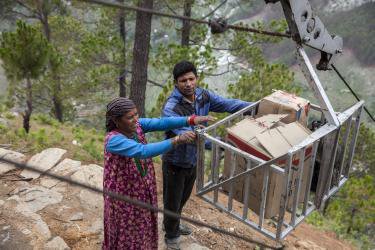
Now following the installation of a gravity goods ropeway, the community is reaping the benefits. Not only does agricultural produce reach the market fresh, but other goods can be easily transported back to the communities.
Saud collects NRs 20 (15 pence) for every 10 kilograms of goods transported, this is used for the maintenance of the ropeway.
With large numbers of women suffering from uterine prolapse, which often occurs when women carry heavy loads too soon after giving birth, the ropeway came as a savior.
Along with constructing the ropeways, the project also helped to establish a committee of 11 members to manage the ropeways. Under the institutionalization component, the project helps them to develop working modality.
Along with other benefits, the BICAS project has developed new multi-use water systems. These provide access to safe drinking water and irrigation facilities for farmers and reduce the time and drudgery required to collect water.
Water is collected in a reservoir tank and fed to taps for domestic and agricultural use among the community. Rainwater, excess water from the tap and the overflow of the reservoir tank are collected in the pond.
This drastically reduces the time and drudgery required to collect water, freeing women and children to focus on productive activities like income generation and studying.
Member Secretary of Social Welfare Council Rajendra Kumar Poudel thanked Practical Action and donor partners, European Union, Jersey Overseas Aid and other local stakeholders, including the local levels, for support to make the project a grand success.
Joint Secretary of Ministry of Agriculture and Livestock Tej Bahadur Subedi said that the ministry is open to work with development partners and INGOs in projects like this that transform the livelihood of people.
Natalija Waldhuber, Junior Professional in Delegation of European Union to Nepal, said that healthy and vibrant civil society can immensely contribute to mobilize people at grassroots level to implement the projects successfully. "I found the deep affection of people towards the project during my visit last April."
Regional director of Practical Action South Asia Achyut Luitel said that BICAS has successfully implemented its schemes in support of the transformation of Nepal into the federal structure.
BICAS project has shown the way to work jointly through the partnership among government offices, Local Body, NGOs and INGO for the betterment of rural life in Nepal.
Inspiring Change
The systematic interventions led by BICAS Project have created strong learning and knowledge through which Practical Action aspires to inspire policies and practices at scale mainly targeting the relevant government bodies and at likeminded development practioners level. During the project period, BICAS came up with some inspiring stories from communities, CSOs and local government bodies with evidences of change in their practices. Some of these stories of inspiration came in form of replication of technologies at local level while some came in form of diversification of business of local market sectors.
Strengthening Agriculture Extension system
The effectiveness and reach of agriculture extension has a direct bearing on the overall performance of rural agriculture. In the new context of federal structure with an explicit role of municipality to undertake agriculture extension work, the extension approach can be tailored to the local context to make it more effective and efficient. Based on the learning from BICAS Project, a public private community collaboration approach seems more relevant for strengthening agriculture extension at the local government level, The collaborate concept advocates on capitalizing and harnessing the market sectors' extensive business network to channelize knowledge and information to the smallholder farmers in rural areas. This can be made more productive and robust by establishing community extension center, an idea also advocated by Nepal's ADS. Linking the agro-vet center to the local market actors such agro-vet and traders who have reach and access to smallholder farmers to deliver information as an embedded service while selling inputs and services as well. Municipality can play meaningful role to build technical capacity of local market actors such a local agro-vets through training and exposure and link it to the knowledge center which has recently been established by province government in the view of new federal structure.
Integration of Urban and rural economy
Rural economy in Karnali and Far West hilly and mountain regions depend upon agriculture and forest sector. Duet to various structural constraints, the cost involved in agri-business is very high leading to poor functioning of local market system. This has led to the poor integration of rural economy to the urban economy. Unless urban market services such as financial, insurance, input and technology services are linked to the rural areas, commercialization of agriculture is not possible. In this connection, learning form BICAS shows that urban business can be linked to rural economy by strengthening and capitalizing local market actors.
A satellite business network and linkage could be an option to minimize risk and cost doing business in rural areas. For example, an insurance company in urban areas can capitalize local actors such as agro-vets and barefoot agro-vets to work as their agent to expand their service delivery network.
Enhanced the Role of CSOs in improving local governance
CSOs can play pivotal role in local economic development through engaging with local government bodies and other development stakeholders. The learning from BICAS reveals that CSOs have limited knowledge and capacity to engage in local development process. To engage CSOs in development process, their knowledge and capacity needs to be strengthen in different areas. Their engagement in planning and decision making process can ensure need based planning and development of the local level. Such engagement can also improve governance and boost the rural economy gradually.
Making economic infrastructure viable
To make economic infrastructure viable with high economic return, such infrastructure should be tied up with potential priority economic sectors that are guided by local economic development plan. Economic infrastructure such as road, electricity and irrigation should be part of broader economic development plan rather than one ad-hoc basis of that builds synergy with other agriculture commercialization interventions and overall impact on infrastructure can be higher.
(Source: The part of the information taken from Unleashing Agriculture Potential in mid and far-west Nepal published by Practical Action)
- MELAMCHI WATER SUPPLY: No Interruption During Monsoon
- Jun 25, 2025
- KOREAN RETURNEES: Successful Integration
- Jun 25, 2025
- UPPER TRISHULI-1: Engaging With Local
- Jun 25, 2025
- IME GROUP: Twenty Five Years Of Journey
- Jun 24, 2025
- NEPAL’S AIR POLLUTION: A Growing Health Concern
- Jun 24, 2025

